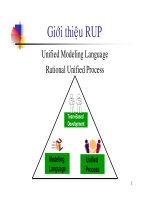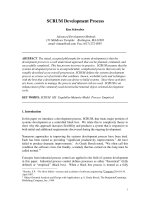Shell Process Tree
Bạn đang xem bản rút gọn của tài liệu. Xem và tải ngay bản đầy đủ của tài liệu tại đây (77.67 KB, 10 trang )
49
■ ■ ■
CHAPTER 8
Shell Process Tree
T
he process-tree script presented in this chapter does exactly what its name suggests: it
prints out the names of some or all of the currently running processes that are present in
the process table, displaying the parent/child relationships that exist among them in the
form of a visual tree. There is an implementation of this functionality on some versions of
Solaris (ptree) and on all flavors of Linux (pstree). These have proved very valuable to me
for finding the root of a process group quickly, especially when that part of the process
tree needs to be shut down.
There are some UNIX-based operating systems that don’t have this functionality, such
as HP-UX; hence the reason for this script. Along the way, this script also demonstrates
several interesting shell programming techniques.
This script was originally a shell wrapper for an awk script
1
whose code I decided to
rewrite for this book using a shell scripting language. All the versions of this script listed
here use the same algorithm. The difference between them is that the first version stores
data within arrays, and the second version uses indirect variables. The last version will run
in the Bourne shell if that is all you have. Although the array version provides a good dem-
onstration of arrays, it is not ideal since it requires bash. While bash may be installed on
many systems, there is no guarantee that you will find it on non-Linux systems. The indi-
rect-variable method is more useful, as it can be run in either ksh or bash with only minor
modifications. You can find a more in-depth explanation of the indirect-variable tech-
nique in Chapter 7.
The following is some sample output from the script. It contains only some of the pro-
cess tree of a running system, but it gives a good impression of the full output.
|\
| 2887 /usr/sbin/klogd -c 3 -2
|\
| 3362 /bin/sh /usr/bin/mysqld_safe
| \
| 3425 /usr/sbin/mysqld --basedir=/usr
| \
1. Based on an
awk
script that was written by Mark Gemmell and posted to the comp.unix.sco.misc
Usenet newsgroup in 1996.
50
CHAPTER 8
■
SHELL PROCESS TREE
| 3542 /usr/sbin/mysqld --basedir=/usr
| |\
| | 3543 /usr/sbin/mysqld --basedir=/usr
| \
| 3547 /usr/sbin/mysqld --basedir=/usr
\
3552 /usr/sbin/sshd
Process Tree Implemented Using Arrays
The concept of the script is simple enough: It can be run with no arguments, and its out-
put is then the complete tree representation of all current entries in the process table. A
process ID (pid) can also be passed to the script, and then the script will generate a tree
displaying that process and its descendants.
By default, the root of the process-tree output is the init process, which has the pro-
cess ID 1. The first part of the code sets the process ID to 1 if no process number has been
passed to the script.
#!/bin/bash
if [ "$1" = "" ]
then
proc=1
else
proc=$1
fi
As its name suggests, the main() function, used in the following code, contains the
main code to be executed. I have defined a main() function here because I wanted to
explain this code first. Functions need to be defined before they can be called, and I would
normally define functions near the beginning of a script and place the main code that
calls these functions after the function definitions. Here I have used a main() function,
which is invoked at the bottom of the script, and put its definition at the top of the script
because it is easier to describe the main logic of the code before dealing with that of the
helper function. Having a main() function is not required in shell scripts, however, (as it is
in, say, C programs) and the script can easily be organized with or without one.
main () {
PSOUT=`ps -ef | grep -v "^UID" | sort -n -k2`
First the script creates a variable containing the current process-table information. The
switches passed to the ps command (here -ef) are typical, but depending on the OS you’re
running, different switches (such as -aux) may be more appropriate. You may also need to
modify the variable assignments to properly reflect these variations. The command usage
in Linux systems is a combination of these types, and ps under Linux will accept both
option sets.
CHAPTER 8
■
SHELL PROCESS TREE
51
The following is the start of the loop that goes through the whole process table and
grabs the needed information for each process:
while read line
do
My first inclination here would be to perform the ps command to generate the process
table; then I would pipe the table to the while loop. That way I would not need to generate
a temporary output file, which would be more efficient.
While the intention would be noble, it wouldn’t work in pdksh or bash. It does, however,
work in ksh. When the output from ps is piped to the loop in pdksh or bash, the loop is
spawned in a subshell, so any variables defined there are not available to the parent shell
after the loop completes. Instead of piping the output of ps to the while loop, the variable
containing the process-table output is redirected into an input file handle from the other
end of the loop, and we get to keep our variable definitions. This technique is discussed
further in Chapter 10.
This loop processes each line of the redirected file one by one and gathers information
about each running system and user process.
Some entries in the process table may have the greater-than (>) character in the out-
put that displays the command being executed. Occurrences of this character (which
means redirection to the shell) must be escaped, or else they may cause the script to act
inappropriately. The sed command in the following code replaces the > character with
the \> character combination. There are other characters, such as the pipe (|), that may
occur in the ps output and present the same issue. In these cases, which are not
accounted for here, additional lines similar to this one would be needed.
line=`echo "$line" | sed -e s/\>/\\\\\\>/g`
Next we need to define an array, here called process, to hold the elements of the ps out-
put line being read. I chose the bash shell to run this version of the script because its array
structure does not enforce an upper bound on the number of array elements or on the
subscripts used to access them. The pdksh shell limits the size of arrays to 1,024 elements,
and ksh93 will allow up to 4,095 array elements. Both shells also require the subscripts that
index the array elements to be integers starting from 0. This latter restriction isn’t a prob-
lem when setting up the array that contains a single line from the ps output. However, the
process ID will be used later as an index into other arrays, and then this limitation does
become a problem. Process IDs are integers commonly greater than 1,024, and it happens
quite frequently that their values reach five-digit numbers.
declare -a process=( $line )
A possible modification would be to use translation tables; that is, arrays associating
smaller subscript values with the actual process ID numbers. The tree structure would
then be created using these values, and it would be possible to print out the original pro-
cess IDs using the translation tables. Even with this modification, you would be limited as
to the number of processes the script could handle. The sample script used here doesn’t
52
CHAPTER 8
■
SHELL PROCESS TREE
have that limitation. Later in this chapter you’ll see a version of this script that uses indi-
rect variables and eval to implement pseudoarrays that allow very large sets of data items
to be accessed individually using arbitrary indexes.
Here’s where the arrays containing process information are populated. These arrays
are indexed by process ID. First we get the pid of the process whose line of information is
being read.
pid=${process[1]}
We use an owner array to hold strings specifying the owner of each process. We store the
name of the current process’s owner in the appropriate array location.
owner[$pid]=${process[0]}
ppid[$pid]=${process[2]}
command[$pid]="`echo $line | awk '{for(i=8;i<=NF;i++) {printf "%s ",$i}}'`"
Next we assign the process ID of the current process's parent to the appropriate ele-
ment of the ppid (parent pid) array.
Then we do the same for the command array, which holds the commands being exe-
cuted by each running process. The difference here is that the command being run isn’t
necessarily a simple value. The command could be just one word, or it could be quite
long. The array-assignment statement pipes the line variable’s current value to an awk
script, which outputs the fields of the ps output line for this process, starting from the
eighth field. This is done using a loop controlled by NF (number of fields), since it cannot
be known in advance how many whitespace-separated fields the command will occupy.
What is known is that the elements of the command string start at the eighth field of the
ps output. Keep in mind that if you change the switches given to the ps command that
generates this output, you may need to modify the awk statement to reflect the new out-
put format.
The last assignment is a bit tricky. The children array is indexed by the pid and each of
its elements contains a list of the pids of the corresponding process’s children.
children[${ppid[$pid]}]="${children[${ppid[$pid]}]} $pid"
This assignment adds the current process’s pid to the list of children of its parent
process. An example may clarify the logic of this step. Consider a process tree consisting
entirely of two processes, process 1 and process 2, where process 2 is the child of pro-
cess 1. Suppose that at this line in the script, the line variable contains the information
for process 2. Then the array assignment adds the current pid (2) to the list stored in the
element of the children array for the process with pid 1. In this way, when the array has
been populated and you want to know the children of a process with a particular pid,
you can access the children array using that pid as the subscript.
The assignment appends the current pid to the children array entry because any given
process may have multiple children. For example, take the process with pid 1 on any
running system. This is the original system-startup process and will have many direct
children. It is not necessary to explicitly track grandchildren (or further descendants), as
CHAPTER 8
■
SHELL PROCESS TREE
53
they will be the direct children of other processes and appear elsewhere in the children
array already.
This completes the loop. As discussed previously, the process table’s file handle is redi-
rected into the loop from the back end.
done <<EOF
$PSOUT
EOF
This is a very efficient algorithm, since it takes in the whole process table and appropri-
ately categorizes all the data in it using only one iteration through the table.
Now that all the data has been read, you can call the function that prints it out in tree
form, which completes the main() function.
print_tree $proc ""
}
The print_tree() function is called with two parameters.
print_tree () {
id=$1
The first is the pid of the process that should be at the root of the tree. The second is
a string that will be prepended to the information about a process to form a line of dis-
played output. This string contains the characters that depict the tree-branch structure
leading up to a tree leaf. The first time the function is called (from the main() function
discussed earlier) the second argument is set to null because the root of the process tree
has no branches leading into it.
This function is used recursively to process the tree level-by-level. As you can see by
examining the sample output shown earlier, the ASCII characters needed to print out a
particular process branch are determined by the branch’s level in the tree and whether it
is the last child of its parent. When we recursively descend one level in the tree to the next
child, this adds one more straight branch symbol and an appropriate slanted branch (or
space) leading into the child.
This is where the output of the process ID, owner and command are printed. You can
add more information, such as parent pid or CPU time, but you would have to modify the
main function.
echo "$2$id" ${owner[$id]} ${command[$id]}
If the process has no children, the function will stop and return to the caller to process
the next tree branch.
if [ "${children[$id]}" = "" ]
then
return
If the process does have child processes associated with it, we loop through the list of
its children so those branches of the tree can be printed.









